|
Africa
2024 Journal Pages:
1
2
3
4
5
6
7
8
9
10
11
12
January 13
We
slept in this morning; our wakeup call wasn’t until 5:30, and we
got on the road about half past six. I rode in front beside Gee.
Rafe was not feeling well so she stayed in camp. As we left camp
we saw the same bateleur from the evening before; he left his
perch and flew across in front of us.
We drove through a grove of rain
trees; they are very beautiful, with multicolored bark like a
sycamore in pastel shades of cream, pale green and tan, and
downward-hanging flowing leaves. This grove was inhabited by
scores of impala and zebras, each with some small babies. A
waterbuck doe blended in to the background.
|
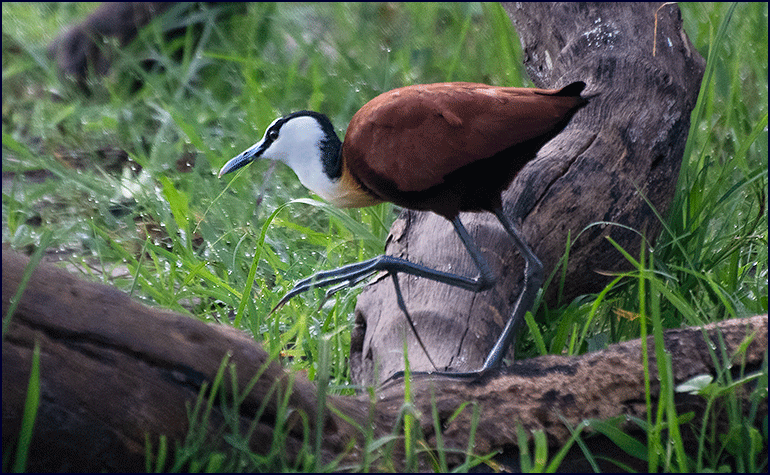
Jacana
|
A jacana waded along the edge of a pool; these long-legged
chestnut birds have black and white heads and necks topped with a
patch of sky blue. They are known as lily trotters, because they
run lightly across the top of the water on the lilypads.
A blacksmith lapwing stood on top of a termite mound,
handsome in his black, white and grey plumage. Their call is a
sort of metallic chink chink,
said to sound like a blacksmith’s hammer striking an anvil. A
sacred ibis strode by; these large waterfowl are white with black
neck and head, legs, and tail. They are rather handsome, with a
long curved beak and a delicate black edging around their white
wings, visible when they fly.
|
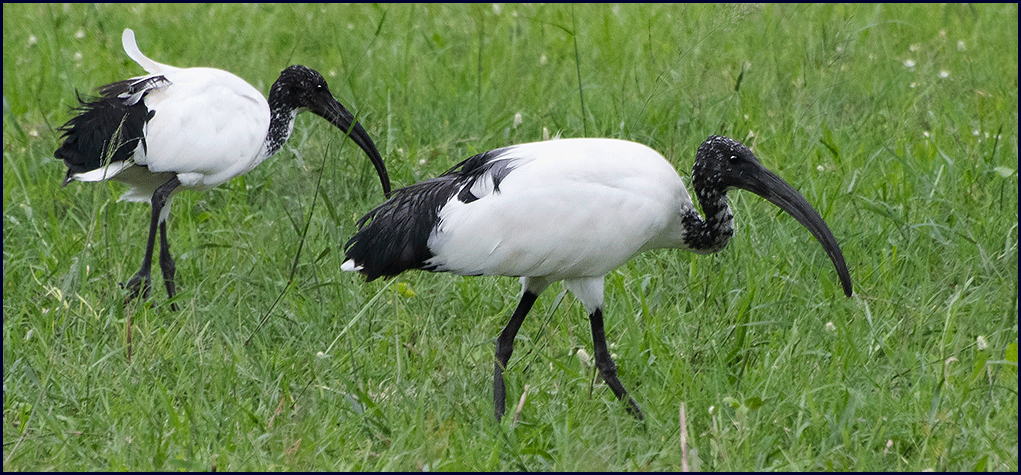
Sacred ibis |
We heard a distinctive call, with notes almost like a
whip-poor-will, but slower, with a long descending trill – Gee
told us it was the call of a woodland kingfisher. Sure enough, we
soon spotted a pair of these beautiful little kingfishers perched
on a branch. They are a pale greyish-white and black, and bright
iridescent blue on their backs, wings and tail. Their beaks are
bright orangey red on the top and black underneath. With their
brilliant blue color and their mesmerizing call, they quickly
became a favorite for all of us.
We stopped to admire a pair of
African hoopoes. They have a reddish-chestnut head, neck and
breast, black and white barred wings and tail, and a reddish crest
with bold black tips. Makomkom Safaris’ logo is an Africa
hoopoe, so we feel a special connection with these handsome birds.
We came out to the edge of a beautiful wetland. The river
meandered through tall marsh grasses, and water lilies lined its
edges. An African darter perched on a dead tree craning its long
elegant neck. A goliath heron sailed above the marsh before
landing with slow-motion wing strokes. We watched as a black and
white pied kingfisher hovered above the water, then suddenly dived
down vertically to grab a tiny fish.
|
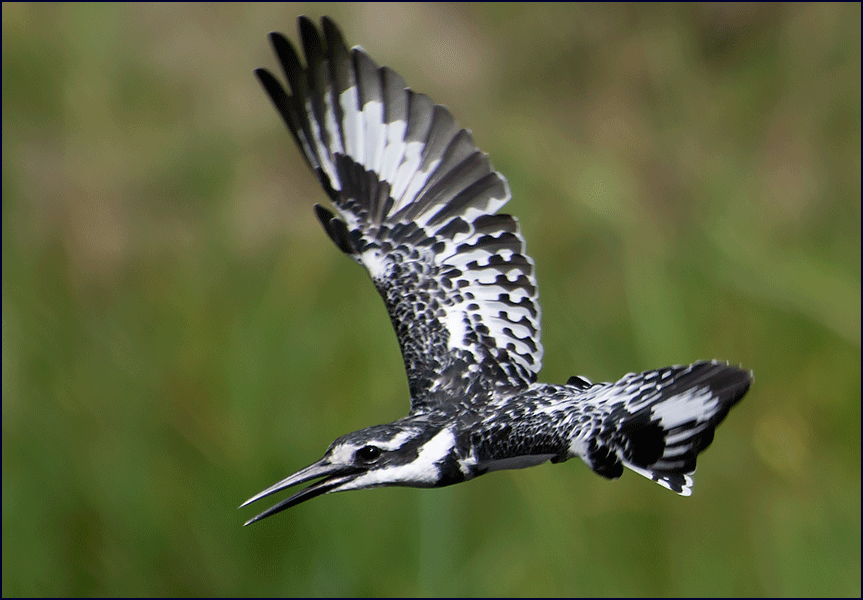
Pied kingfisher
|
Gee was driving along a small sand road when suddenly he
saw fresh tracks; he stopped the land cruiser and got out to
investigate. “Lions crossed the road here – many lions. You
can see where they lay down and slept,” he told us. We weren’t
sure it was wise for him to be out of the land cruiser, but we
noticed he didn’t go far from the vehicle.
We drove off through the bushes following the tracks,
looking among the trees for the lions while avoiding branches and
stumps. After about ten minutes I looked off to the right; lions
at two o'clock! (We used the clock designation to let each other
know where to look when something was sighted; we’d had to
remind each other that twelve o'clock was based on the direction
the vehicle was pointing, not the way someone happened to be
looking at the moment!)
There was a pride of lions lying in the shade under some
scrubby trees, alert, not yet settled in for the day’s sleep.
There were six of them; two mothers and four mostly-grown cubs.
Gee estimated the young ones to be about a year old, two males and
two females. From time to time they sat up and looked around, and
before long several of them got up and moved to a shadier spot,
and soon the others followed them. The youngsters tussled a
little, and one rolled over on his back with his legs in the air.
Another yawned extravagantly, and then chewed on a branch a little
before turning and pouncing on his littermate. Just like kittens
everywhere! The two mothers dozed contentedly.
We spent about an hour with the lions. We marveled once
again at Gee’s ability to read the tracks and find these amazing
creatures. The self-drivers never would have seen this!
We came back out to the floodplains, marveling at the huge
variety of waterfowl and birds. Brown and white Squacco herons,
attractive and dainty, stood next to egrets and jacanas. The large
yellow-billed storks and woolly-necked storks shared the area with
Egyptian geese, spoonbills and ibis. We saw an open-billed stork,
an interesting black bird with a huge bill that didn’t quite
close all the way. A lilac-breasted roller stood on a termite
mound, and we watched as he took flight, trying to capture the
colorful moment with our cameras. A cape turtle dove perched on a
dead stump near us; it had a course hair in its mouth. Was it the
hair from an elephant’s tail? Maybe this dove was a level 3
guide.
A huge lagoon stretched before us; we were on the back side
of Dombo Pools, an area that had seemed so mysterious when passing
through on previous trips. We watched lechwes run across the
floodplain in front of us. A yellow-billed kite soared overhead.
We took a tea break beneath a
lovely spinney of rain trees. We could see open water and tall
pampas grass nearby, and Gee pointed out turpentine grass and
cotton-wool grass. Butterflies and dragonflies flitted all around;
the dragonflies especially seemed to be attracted to people, and
followed us about.
A water monitor lizard was walking along beside a channel.
These reptiles are huge - they can grow to over six feet long, but
this one was only about four. Black with yellow markings, he had
an impressive strong tail. We watched as he swerved through the
grass and into the water, swimming away gracefully with just his
head out of the water.
|
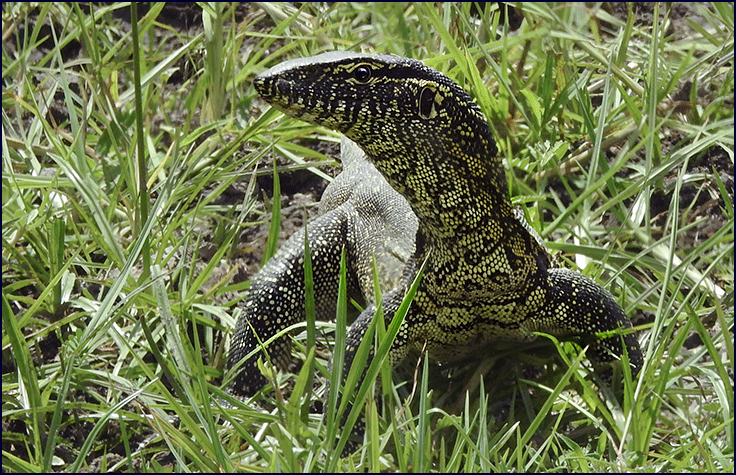
Water monitor lizard
|
We encountered a small herd of elephants feeding, and
stopped to watch them for a while. Then we headed back to camp,
getting there around noon. It had been a great morning. We had
some lunch and rested a little, sitting in the camp chairs in font
or our tents and enjoying the view, watching the lechwes at the
waterhole and listening to the trilling call of the woodland
kingfishers.
We had tea at 3:30; Mosa and Kilos had made us an
incredible lemon drizzle cake. We were still full from lunch, but
we ate it enthusiastically anyway before going out for the
afternoon drive.
Gee took us to the front side of Dombo Pools, to our usual
lunch spot from previous trips, and we sat looking out over the
vast lagoon. It was a lovely, peaceful scene. Stormy clouds lined
the horizon, and we could hear the distant rumble of thunder. Far
across the lagoon we could see several hippos out of the water,
and lechwes grazed in the marshes.
The hippos near the shore honked and chortled, threatening
us with open mouths. One big bull reared up out of the water, his
mouth stretched wide, showing us his remarkable huge teeth. Water
streamed from his open jowls as he shook his head at us angrily.
We were crossing a stream in an open field near camp when
we hit a hole and the land cruiser got stuck. Gee revved the
engine, rocking forward and backwards to try to free it, but to no
avail. He got out the high-lift jack and started jacking up the
vehicle while the rest of us collected wood and branches to put
under the wheel. This was not the first time we had been stuck in
the Delta!
Suddenly we saw a person walking toward us - it was Mosa!
He had heard the engine revving, and walked from camp to see if we
needed help. We had gotten branches under one rear tire for
traction but it was evident this process would need to be repeated
with the other wheels, so Mosa returned to camp and sent More with
the camp truck to pull us out.
More
backed up to the land cruiser and produced the world’s oldest
and flimsiest tow rope. Gee hooked it up and got into the
driver’s seat, hoping the tow rope combined with the increased
traction from the branches would be enough to get us unstuck. But
instead of easing the slack out of the rope and slowly, carefully
pulling us out, More backed up the truck to get the line slack,
and then floored it. “No,” we cried, as the inevitable
happened and the tow rope snapped like a piece of twine. After
tying it back together and repeating this unsuccessful process
again, on the third try More gently eased forward and successfully
pulled the land cruiser out of the muck. Success!!
The storm clouds were gathering and the light was starting
to fade as we drove on from where we had been mired.
Guinea fowl scurried through the bushes, and two warthogs
did an extended trot across the road in front of us, tails
straight up over their backs as usual - turns out they are very
good movers. Two hippos were grazing in the tall grass near a
lagoon, accompanied by several white egrets; at our approach they
headed for the water and smoothly slid in.
We went back to where we had seen the lions in the morning;
they were still in the same place, and starting to wake up. We
watched them romp and tussle. One of the young males lay down on
top of the other one, wrestling and coaxing him to play. The
mothers got up and looked around, no doubt planning a hunt. We
were glad Rafe had a chance to see the lions, since she had missed
them when she stayed in that morning.
|
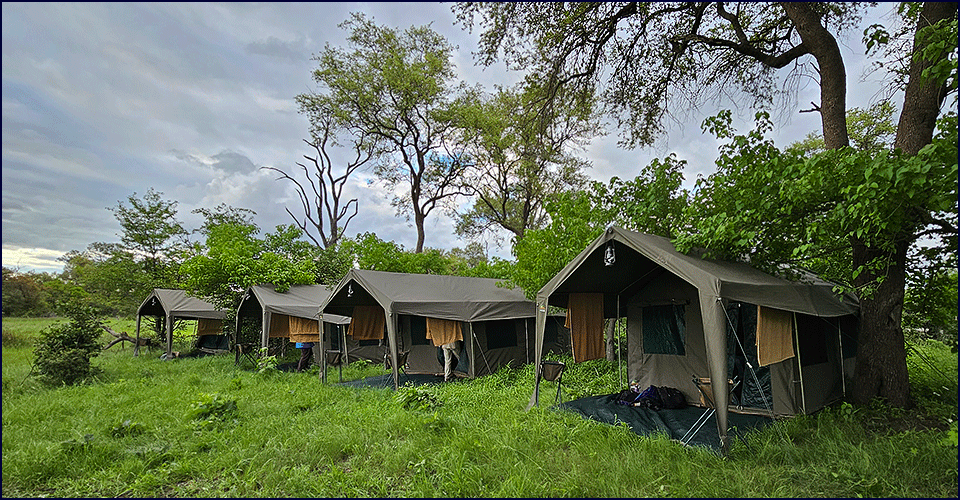
Moremi camp |
It was getting dark, and a big storm was blowing up – we
could see rain all around us. I was time to head back to camp. The
same bateleur eagle was in the tree by camp again, and lechwes
were at the waterhole. Before dinner Janell walked over to our
tent and to her surprise found a vervet monkey sitting in one of
the chairs on our porch. We watched
a brilliant sunset while enjoying a sundowners drink.
Another wonderful dinner, with excellent food and great
company, reliving the best moments of the day. A bucket shower
cooled me off for a good night’s sleep. We could hear the hippos
in the night; their honking sounds like maniacal laughter, and
always just cracks me up. In the early hours of the morning a
hyena passed by with a soft, quizzical whoop,
whoop call.
January 14
We were up early Sunday
morning, and watched a beautiful sunrise. Gee, who is also a
minister in his church, conducted a brief sermon/blessing. Then we
piled in the land cruiser and headed out across the
wetlands.
Gee pointed out aardvark tracks in
the road, with three elongated toes and a small thumb-like print.
This made them feel a little more real to me; despite seeing
numerous aardvark holes they seem kind of like mythical creatures.
We heard a trilling call, and suddenly spotted a woodland
kingfisher sitting on a twig, right beside the road. He posed for
us for several minutes, and I was happy to get such a close photo
op of one of these brilliant birds.
|
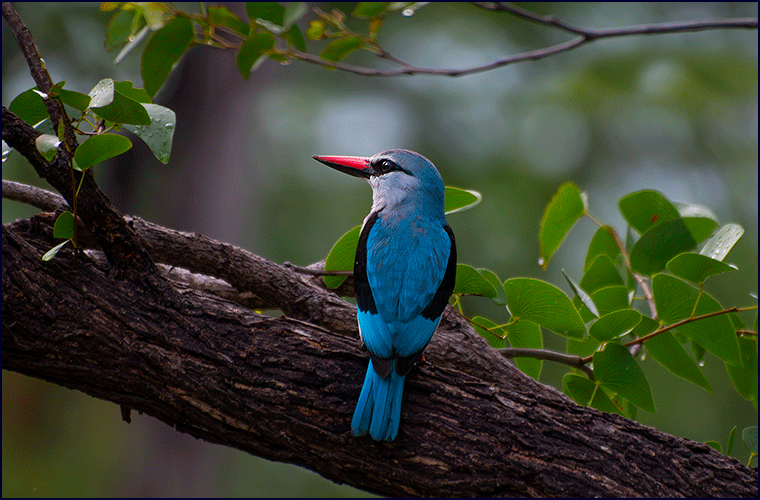
Woodland kingfisher
|
Gee explained to us how the mopane trees have a system to
protect themselves. When an animal starts eating the leaves the
tree secretes a pheromone that turns the taste bitter, encouraging
the animals to move on. The leaves also have a warning system; the
yellow ones taste somewhat bitter, but if they turn red they are
really bad, and possibly toxic. We noticed the branches of many of
the trees we passed had yellow and red tips - the trees’
protection system at work.
A mother impala stood with about six babies; an impala
daycare center. It is interesting how many of the animals have
such a daycare system; we have also seen it in wildebeests,
giraffes, elephants, and zebras. Lions and hyenas will also help
look after each other’s babies.
|
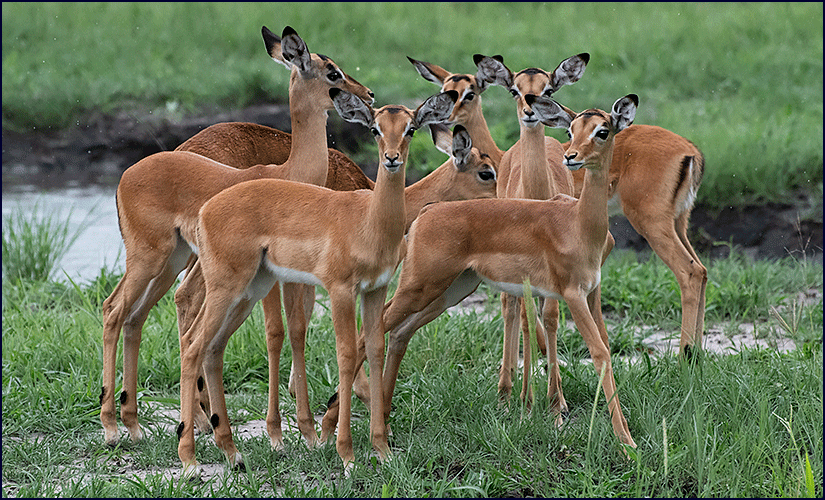
Impala daycare
|
It was around eight o'clock when we came out to another
large lagoon. We saw the usual assortment of waterfowl along the
floodplain, including woolly-necked storks, comb ducks,
white-faced ducks, and Egyptian geese. A black-winged stilt was
wading, and a grey heron stood on the shore.
Two spoonbills appeared to be fighting. Several sacred ibis
flew by close, allowing us to admire the lacey black edging on
their outstretched wings. A pair of hamerkops were courting in a
tree.
|
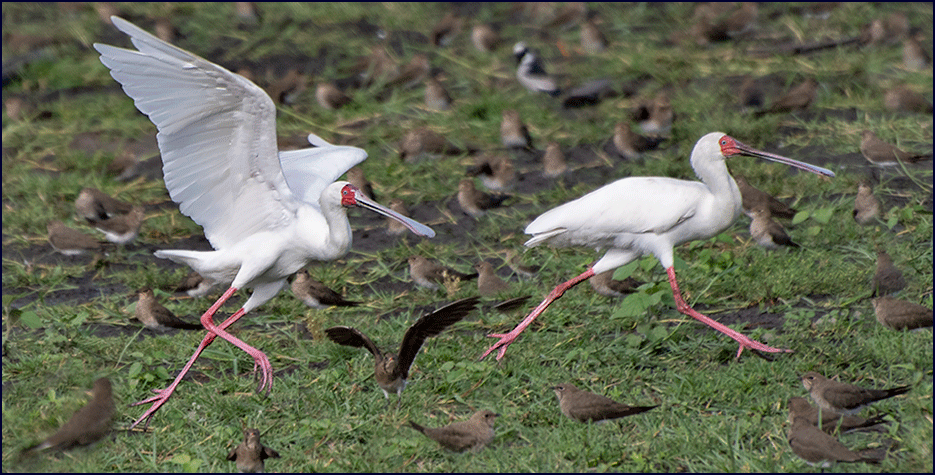
Spoonbills
|
Suddenly two big flocks of birds flew in, more or less at the same
time. First a group of ducks came gliding in, did a few loops
around the lagoon, and landed on the water. Gee said they were
fulvous ducks, and he had never seen them before - we felt lucky
to be on a ‘first’ sighting with Gee. Then thousands of
smallish birds with swallow tails swooped in like a dark cloud,
the whole flock wheeling and turning in unison; Gee identified
them as red-winged pratincoles. They were mesmerizing to watch.
|
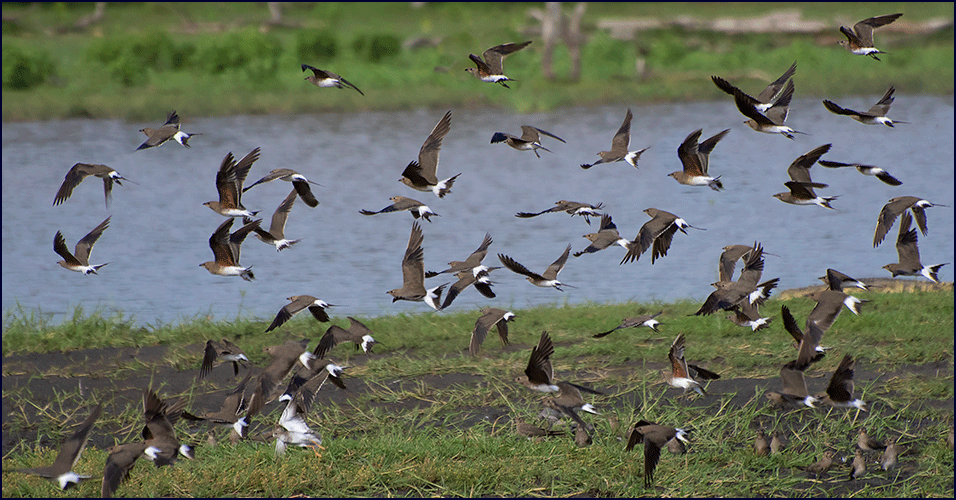
Red-winged
pratincoles |
A yellow-billed stork was wading through the water quite
close to the road, searching for food. He poked his long beak down
into the mud and came up with a frog; he shook it vigorously back
and forth, and then tossed it in the air and caught it again
repeatedly. Gee said he was breaking the frog’s bones before
eating it. Poor frog.
We continued around the wetlands, seeing an abundance of
birds - Gee could identify every one. We paused to watch a pair of
little bee-eaters; these pretty birds are green and yellow, with a
black mask over their eyes. They would sit motionless on a twig
waiting, and then suddenly be off like a flash to grab an insect
before returning to the same twig.
We stopped at ten for our tea break under a grove of
beautiful rain trees. Hundreds of barn swallows were circling and
swooping over the grass in front of the trees. These attractive
dark blue birds with reddish breasts look just like the barn
swallows we have at home. We watched them skimming gracefully over
the plain. After about twenty minutes we headed out again.
~
Continued
on next page ~
Africa
2024 Pages:
1
2
3
4
5
6
7
8
9
10
11
12
Back
to the AFRICA 2024 INDEX Page
|